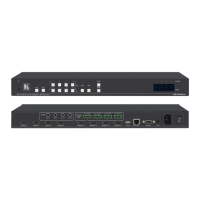Kramer Electronics Ltd.
Copy EDID data from the
output to the input
EEPROM.
Destination bitmap size
depends on device
properties (for 64 inputs it
is a 64-bit word).
Example: bitmap 0x0013
means inputs 1,2 and 5
are loaded with the new
EDID.
In certain products
Safe_mode is an optional
parameter. See the HELP
command for its
availability.
COMMAND
#CPEDIDedid_io, src_id, edid_io, dest_bitmap<CR>
or
#CPEDIDedid_io, src_id, edid_io, dest_bitmap, safe_mode<CR>
FEEDBACK
~nn@CPEDIDedid_io, src_id, edid_io, dest_bitmap<CR><LF>
~nn@CPEDIDedid_io, src_id, edid_io, dest_bitmap,
safe_mode<CR><LF>
edid_io – EDID source type (usually
output)
0 – Input
1 – Output
2 – Default EDID
3 – Custom EDID
src_id – Number of chosen source
stage
0 – Default EDID source
1 – Output 1
2 – Output 2
edid_io – EDID destination type
(usually input)
0 – Input
1 – Output
2 – Default EDID
3 – Custom EDID
dest_bitmap – Bitmap representing
destination IDs. Format: XXXX…X,
where X is hex digit. The binary form of
every hex digit represents
corresponding destinations.
0 – indicates that EDID data is not
copied to this destination.
1 – indicates that EDID data is
copied to this destination.
safe_mode – Safe mode
0 – device accepts the EDID as is
without trying to adjust
1 – device tries to adjust the EDID
(default value if no parameter is
sent)
Copy the EDID data from the
Output 1 (EDID source) to the
Input:
#CPEDID1,1,0,0x1 <CR>
Copy the EDID data from the
default EDID source to the
Input:
#CPEDID2,0,0,0x1<CR>
COMMAND
#DISPLAY?out_index<CR>
FEEDBACK
~nn@DISPLAYout_index, status<CR><LF>
out_index – Number that indicates
the specific output: 1-4
status – HPD status according to
signal validation
0 – Signal or sink is not valid
1 – Signal or sink is valid
2 – Sink and EDID is valid
Get the output HPD status of
Output 1:
#DISPLAY?1<CR>
Set Ethernet port protocol.
If the port number you
enter is already in use, an
error is returned.
The port number must be
within the following range:
0-(2^16-1).
COMMAND
#ETH-PORT port_type, port_id<CR>
FEEDBACK
~nn@ETH-PORT port_type, port_id<CR><LF>
port_type – TCP/UDP
port_id – TCP/UDP port number
(0 – 65535)
Set the Ethernet port protocol
for TCP to port 12457:
#ETH-PORT 0,12457<CR>
Get Ethernet port protocol.
COMMAND
#ETH-PORT? port_type<CR>
FEEDBACK
~nn@ETH-PORT port_type, port_id<CR><LF>
port_type – TCP/UDP
0 – TCP
1 – UDP
port_id – TCP / UDP port number
(0 – 65535)
Get the Ethernet port protocol
for UDP:
#ETH-PORT? 1<CR>
Reset device to factory
default configuration.
This command deletes
all user data from the
device. The deletion can
take some time.
Your device may require
powering off and powering
on for the changes to take
effect.
COMMAND
#FACTORY<CR>
FEEDBACK
~nn@FACTORYok<CR><LF>
Reset the device to factory
default configuration:
#FACTORY<CR>
Get EDID support on
certain input/output.
For old devices that do
not support this command,
~nn@ERR 002<CR><LF>
is received.
COMMAND
#GEDIDio_mode, in_index<CR>
FEEDBACK
~nn@GEDIDio_mode, in_index, size<CR><LF>
io_mode – Input/Output
0 – Input
1 – Output
2 – Default EDID
3 – Custom EDID
in_index – Number that indicates the
specific input: 1-4
size – Size of data to be sent from
device, 0 means no EDID support
Get EDID support information
for input 1:
#GEDID 1<CR>

